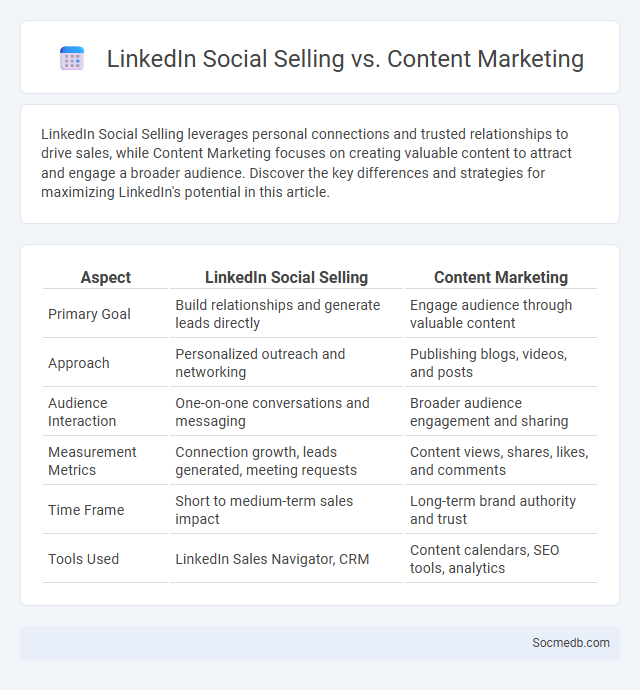
Photo illustration: LinkedIn Social Selling vs Content Marketing
LinkedIn Social Selling leverages personal connections and trusted relationships to drive sales, while Content Marketing focuses on creating valuable content to attract and engage a broader audience. Discover the key differences and strategies for maximizing LinkedIn's potential in this article.
Table of Comparison
| Aspect | LinkedIn Social Selling | Content Marketing |
|---|---|---|
| Primary Goal | Build relationships and generate leads directly | Engage audience through valuable content |
| Approach | Personalized outreach and networking | Publishing blogs, videos, and posts |
| Audience Interaction | One-on-one conversations and messaging | Broader audience engagement and sharing |
| Measurement Metrics | Connection growth, leads generated, meeting requests | Content views, shares, likes, and comments |
| Time Frame | Short to medium-term sales impact | Long-term brand authority and trust |
| Tools Used | LinkedIn Sales Navigator, CRM | Content calendars, SEO tools, analytics |
Introduction to LinkedIn Social Selling
LinkedIn social selling leverages the platform's professional network to build relationships, establish trust, and drive sales by engaging with potential clients through personalized content and meaningful interactions. By utilizing LinkedIn's advanced search filters, Sales Navigator tools, and content-sharing features, sales professionals can identify key decision-makers and nurture leads effectively. This approach enhances brand credibility and accelerates the sales cycle by tapping into a highly targeted and business-oriented audience.
Defining Content Marketing in the Digital Age
Content marketing in the digital age revolves around creating and distributing valuable, relevant content tailored to resonate with your target audience across various social media platforms. By leveraging data-driven insights and SEO strategies, content marketing enhances brand visibility, engagement, and conversion rates in an increasingly competitive digital landscape. Effective content marketing integrates multimedia elements such as videos, blogs, and infographics to maximize reach and influence on platforms like Instagram, Facebook, and LinkedIn.
What Is Social Selling? Key Concepts
Social selling involves leveraging social media platforms like LinkedIn, Twitter, and Facebook to build relationships and engage potential customers by sharing relevant content and personalized communication. Key concepts include social listening to monitor audience needs, influencer engagement to enhance credibility, and using CRM tools for tracking interactions and sales opportunities. Effective social selling increases brand awareness, fosters trust, and accelerates the buying process in B2B and B2C markets.
LinkedIn Social Selling vs Traditional Social Selling
LinkedIn Social Selling leverages advanced algorithms, professional networks, and targeted content to foster authentic relationships and generate high-quality B2B leads, outperforming Traditional Social Selling methods that rely on broad cold outreach and generic messaging. This platform's data-driven insights enable personalized engagement and streamlined sales processes, increasing conversion rates and building long-term customer trust. Companies adopting LinkedIn Social Selling report up to 45% higher lead conversion and deeper audience segmentation compared to traditional approaches.
Comparing Content Marketing and Social Selling
Content marketing emphasizes creating valuable, relevant content to attract and engage a target audience, building brand awareness and trust over time. Social selling leverages social media platforms to directly connect with potential customers, nurturing relationships and driving sales through personalized interactions. While content marketing focuses on broad audience engagement and long-term brand building, social selling targets individual prospects for immediate transaction opportunities.
Advantages of LinkedIn Social Selling
LinkedIn Social Selling enables you to leverage a vast professional network of over 900 million users to build authentic relationships and generate high-quality leads. Its advanced targeting features and AI-driven insights enhance your ability to identify decision-makers and tailor personalized outreach. This method significantly improves your sales conversion rates by fostering trust and demonstrating expertise in your industry.
Content Marketing Strategies for B2B Success
Effective content marketing strategies for B2B success on social media emphasize creating valuable, industry-specific content that addresses target audience pain points and showcases thought leadership. Leveraging LinkedIn's advanced targeting features and publishing informative whitepapers, case studies, and webinars increases engagement and lead generation. Consistent data-driven optimization and integration of marketing automation tools enhance campaign performance and foster long-term client relationships.
Integrating Social Selling with Content Marketing
Integrating social selling with content marketing drives higher engagement and builds trust with Your audience by delivering valuable, relevant content directly through social platforms. Leveraging data-driven insights, you can tailor content to meet your prospects' needs, nurturing relationships that lead to meaningful conversions. Optimizing social media channels for seamless interaction maximizes the impact of both strategies, enhancing brand authority and sales performance.
Measuring ROI: LinkedIn Social Selling vs Content Marketing
Measuring ROI in LinkedIn social selling involves tracking metrics such as lead conversions, engagement rates, and direct sales attributed to personalized outreach and relationship building. Content marketing ROI on LinkedIn focuses on content engagement, brand awareness, click-through rates, and lead generation from organic posts and sponsored content campaigns. Businesses often find a combined strategy enhances ROI by leveraging social selling's direct influence and content marketing's broad audience reach for sustainable growth.
Choosing the Right Approach for Your Business
Selecting the right social media strategy hinges on understanding your target audience, business goals, and platform characteristics. Businesses should analyze demographic data, user behavior, and content preferences to tailor campaigns that maximize engagement and conversion. Leveraging tools like analytics and A/B testing refines approaches, ensuring optimized ROI and brand visibility.
 socmedb.com
socmedb.com